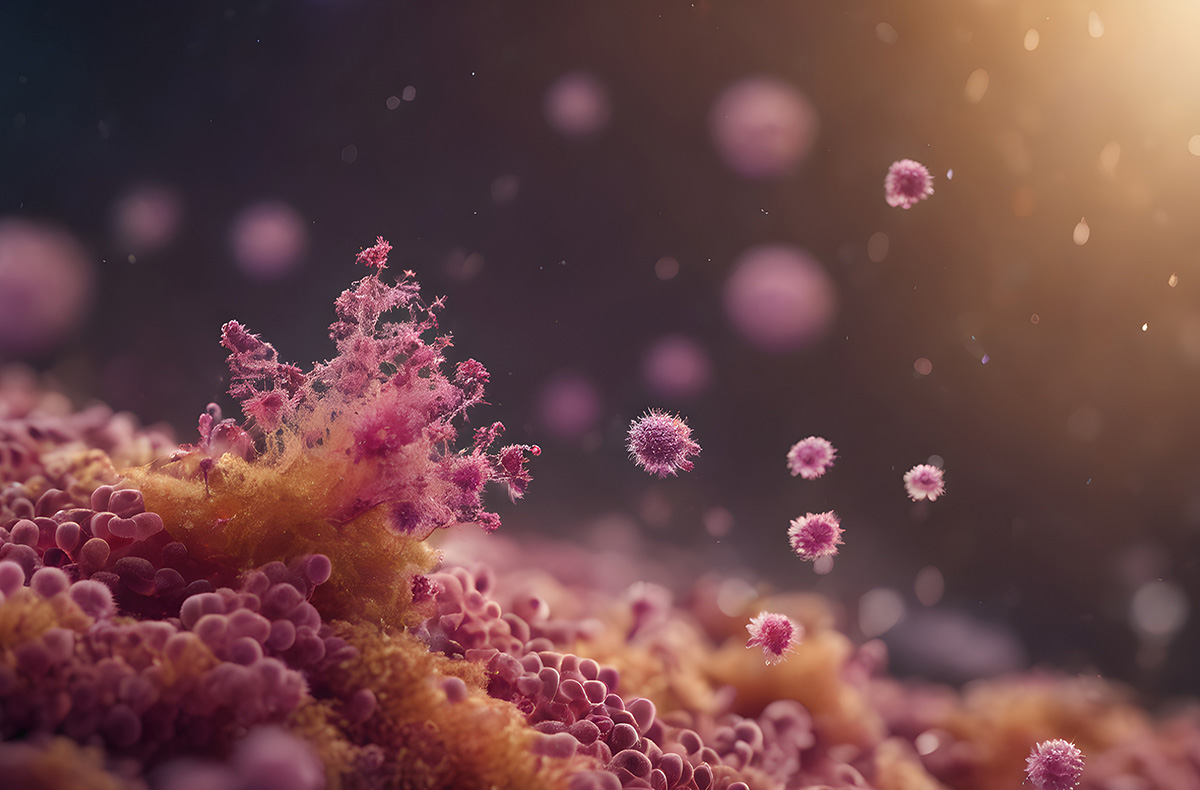En el intestino existe un sistema inmunitario muy potente y especializado. Se cree que alrededor del 80% de las células inmunitarias de nuestro cuerpo residen aquí. Esto nos puede parecer exagerado, pero hay que comprender por qué. El tubo digestivo es una de las barreras que separan a nuestro cuerpo del mundo exterior, junto con los pulmones, la piel y otras mucosas como la oral o la vaginal. De todas esas barreras, es la que tiene una superficie mayor. Clásicamente, se ha hablado de unos 250 a 300 m2 de superficie de intercambio, es decir, el tamaño de un campo de tenis. Sin embargo, recientes publicaciones hablan de una superficie menor, aunque aún así muy importante, de unos 32 m2, lo equivalente a media pista de bádminton. Por ello, podemos considerar que es la principal “aduana” de nuestro cuerpo. Cada día llegan al intestino millones de sustancias (moléculas de los alimentos, microorganismos, tóxicos, etc.), y este órgano tiene que decidir para cada una de ellas si debe dejarlas pasar al interior del cuerpo o no. Para ello, además de la función de los enterocitos (las células que tapizan la pared intestinal), cuenta con la ayuda del sistema inmunitario, que hace de policía de aduanas y le va pidiendo el “pasaporte” a cada una de esas sustancias.
Bibliografía:
Arponen S (2021). Es la microbiota, idiota. Alienta.
Maynard CL, Elson CO, Hatton RD, Weaver CT. Reciprocal interactions of the intestinal microbiota and immune system. Nature. 2012 Sep 13;489(7415):231-41.
Cryan JF, O’Riordan KJ, Cowan CSM, Sandhu KV, Bastiaanssen TFS, et al. The Microbiota-Gut-Brain Axis. Physiol Rev. 2019 Oct 1;99(4):1877-2013.
Takiishi T, Fenero CIM, Câmara NOS. Intestinal barrier and gut microbiota: Shaping our immune responses throughout life. Tissue Barriers. 2017 Oct 2;5(4)
Martin-Gallausiaux C, Marinelli L, Blottiere HH, Larraufie P, Lapaque N. Short Chain Fatty Acids – mechanisms and functional importance in the gut. Proceedings of the Nutrition Society, 2021, 80 (1), pp. 37-49.
Helander HF, Fändriks L. Surface area of the digestive tract – revisited. Scand J Gastroenterol. 2014 Jun;49(6):681-9.
Maynard CL, Elson CO, Hatton RD, Weaver CT. Reciprocal interactions of the intestinal microbiota and immune system. Nature. 2012 Sep 13;489(7415):231-41.
Cryan JF, O’Riordan KJ, Cowan CSM, Sandhu KV, Bastiaanssen TFS, et al. The Microbiota-Gut-Brain Axis. Physiol Rev. 2019 Oct 1;99(4):1877-2013.
Takiishi T, Fenero CIM, Câmara NOS. Intestinal barrier and gut microbiota: Shaping our immune responses throughout life. Tissue Barriers. 2017 Oct 2;5(4).
Mitchell NM, Johnson JR, Johnston B, Curtiss R 3rd, Mellata M. Zoonotic potential of Escherichia coli isolates from retail chicken meat products and eggs. Appl Environ Microbiol. 2015 Feb;81(3):1177-87.
Buberg ML, Mo SS, Sekse C, Sunde M, Wasteson Y, Witsø IL. Population structure and uropathogenic potential of extended-spectrum cephalosporin-resistant Escherichia coli from retail chicken meat. BMC Microbiol. 2021 Mar 29;21(1):94.
Magruder M, Sholi AN, Gong C, et al. Gut uropathogen abundance is a risk factor for development of bacteriuria and urinary tract infection. Nat Commun. 2019;10(1):5521.
Magruder M, Edusei E, Zhang L, et al. Gut commensal microbiota and decreased risk for Enterobacteriaceae bacteriuria and urinary tract infection. Gut Microbes. 2020;12(1):1805281.
Spaulding CN, Klein RD, Ruer S, et al. Selective depletion of uropathogenic E. coli from the gut by a FimH antagonist. Nature. 2017;546(7659):528-532.
Jones-Freeman B, Chonwerawong M, Marcelino VR, Deshpande AV, Forster SC, Starkey MR. The microbiome and host mucosal interactions in urinary tract diseases. Mucosal Immunol. 2021 Jul;14(4):779-792.
Mitchell NM, Johnson JR, Johnston B, Curtiss R 3rd, Mellata M. Zoonotic potential of Escherichia coli isolates from retail chicken meat products and eggs. Appl Environ Microbiol. 2015 Feb;81(3):1177-87.
Buberg ML, Mo SS, Sekse C, Sunde M, Wasteson Y, Witsø IL. Population structure and uropathogenic potential of extended-spectrum cephalosporin-resistant Escherichia coli from retail chicken meat. BMC Microbiol. 2021 Mar 29;21(1):94.

